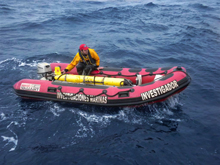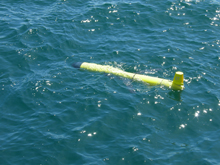First unmanned underwater robot to cross an ocean Highlighted at Smithsonian Ocean Hall
05 Feb 2011
As part of the Deepwater Horizon BP oil spill response effort, US Integrated Ocean Observing System (IOOS) partners deployed a fleet of gliders equipped with sensors to help indicate the presence of oil. Although scientists must still confirm the oil through water sampling, the gliders narrowed the search zone for subsurface oil.
The first underwater robotic vehicle - or "glider" - to cross an ocean is the centerpiece of a new exhibit in the Sant Ocean Hall at the Smithsonian National Museum of Natural History. The exhibit opened on December 9. The US Integrated Ocean Observing System (IOOS) glider, operated by Rutgers University, carried out the trans-Atlantic journey last year, just months before scientists applied the technology to the Deepwater Horizon BP response.
 |
| The Scarlet Knight was picked up off the Spanish coast by the M/V Investigador. Photo courtesy: Rutgers University. |
Rutgers scientists and students launched the trans-Atlantic glider, dubbed ''the Scarlet Knight'' in honor of the school's mascot, off the New Jersey coast in April 2009. Puertos Del Estado (the Spanish Port Authority) helped IOOS scientists recover the glider near Spain in December. They brought it ashore in the small town of Baiona, where Christopher Columbus' ship, the Pinta, landed with news of the New World more than 500 years ago.
The glider traveled a total of 7,409.6 kilometers (4,604 miles) over 221 days, reaching Baiona on December 9, 2009. In still water, the glider flies about 0.5 knots (about 0.58 miles per hour). Ocean currents can speed up or slow down the progress.
''Gliders sample the ocean in places it is impractical to send people and at a fraction of the cost,'' said Zdenka Willis, director of the U.S. IOOS Program. ''Using robots to collect scientific data is the wave of the future in terms of ocean observing.''
 |
| The glider in flight. Photo courtesy: Rutgers University. |
Gliders collect data such as temperature, salinity, currents, and density that describe conditions below the surface of the sea and at varying depths.
IOOS is a federal, regional, and private-sector partnership working to enhance our ability to collect, deliver, and use ocean information. IOOS delivers the data and information needed to increase understanding of our oceans and coasts, so decision-makers can act to improve safety, enhance the economy, and protect the environment.






























